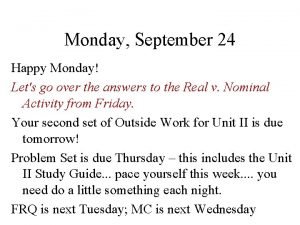Happy Monday 2 6 17 Come in Quietly
















- Slides: 16

Happy Monday 2 -6 -17 • Come in Quietly • Pick up a new C-note paper – Topic: Climate & Climate regions • Have your binder open to page 244 • Begin writing in your planner for the week – I will bring grades around soon

Climate & Climate Regions 7. 3 How do scientists differentiate b/w weather and climate? SC. 6. E. 7. 6 What natural factors can cause climate change? SC. 6. E. 7. 4, SC. 6. E. 7. 6, LA. 6. 2. 2. 3, MA. 6. A. 3. 6

How do scientists differentiate between WEATHER & CLIMATE? Weather Climate • Refers to the conditions of Earth’s atmosphere at a particular time and place • Refers to the typical weather pattern over a long period of time • 2 major factors used in determining CLIMATE – Precipitation – Temperature

Reading Climate Graphs: A graph of temperature can be combined with a graph of precipitation to form a climate graph. The graphs below show climate data for Makindu, Kenya.

Tropical Rainy Climates • Rainy days and afternoon thunderstorms are common • Trade winds bring moisture from the oceans • Lots of Vegetation – Rain forests—forests where large amounts of rain fall year-round – Savannas—tropical grasslands—can be found in Tropical Rainy climates that have distinct dry and rainy seasons.

Dry Climates • A climate is dry if the amount of precipitation that falls is less than the amount that can evaporate • Deserts—very dry regions with extreme temperatures. • Steppes—generally dry areas receiving enough rainfall for short grasses and low bushes to form (Great Plains)

Happy Tuesday 2 -7 -17 • Come in Quietly • Have your binder out and open to page 246 • Have your C-notes from yesterday out and ready to begin • (TB 1 & 2 - 7. 1/2 WS in the basket)

Temperate Continental Climates • Not influenced by oceans • Usually have temperature extremes • Cold winters and hot/humid summers – Subarctic—lie north of some continental climates —Fir and spruce forests often grow here.

Temperate Marine Climate • Usually found along coasts that are in latitudes just outside of the tropics. • Climates are humid and have mild winters • Humid Subtropical—temperate marine climates that are wet and warm, but not as constantly hot as the tropics – Most of Florida is Humid Subtropical

Polar Climates • The coldest climates • Tundra—treeless plains beneath which the ground may always be frozen • Permafrost—permanently frozen ground Climate Video Clip

What Natural Factors can cause Climate Change? • Movement of continents – About 200 million years ago, most of the land on Earth was part of a single continent, Pangea – Continents moved over time which changed locations of land sea slowly changing the climate • Earth’s position and Ice Ages – When Earth’s orbit is more elliptical, less sunlight reaches Earth. – Can cause Earth to experience an Ice Age

What Natural Factors can cause Climate Change? • Volcanic Activity – Major Volcanic eruptions release huge quantitates of ash and aerosols (solid particles or liquid drops in gas) – These stay in the upper atmosphere for months to years and can reflect some solar radiation • Solar Energy – Short-term climate changes have been linked to changes in the amount of light given off by the sun – Sunspots- Dark, cool regions on Sun’s surface

Which Climate region?

Which Climate region?

Which Climate region?

Which Climate region?
 You are happy i am happy
You are happy i am happy Quietly happy meaning
Quietly happy meaning Come rico, come sano
Come rico, come sano Sit2play down
Sit2play down Character chart for the outsiders answers
Character chart for the outsiders answers Happy monday november
Happy monday november Econmovies episode 5 worksheet answers
Econmovies episode 5 worksheet answers Happy monday jr password
Happy monday jr password Happy monday questions
Happy monday questions Happy monday quiz
Happy monday quiz Happy monday november 1st
Happy monday november 1st Happy monday welcome back
Happy monday welcome back December morning greetings
December morning greetings Fake monday
Fake monday Happy monday hope you had a great weekend
Happy monday hope you had a great weekend Happy monday november 1st
Happy monday november 1st Happy monday answer key
Happy monday answer key































